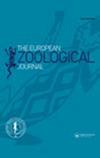Pro-oxidative challenges and antioxidant protection during larval development of non-mulberry silkworm, Antheraea mylitta (Lepidoptera: Saturniidae)
引用次数: 9
Abstract
Abstract The non-mulberry silkworm, Antheraea mylitta Drury, 1773, is important for the silk industry. Its larvae are phytophagous and pass through five stages (1st–5th instar) during larval development. Cellular events during their development contribute to increased levels of pro-oxidants. Antioxidant defences are, therefore, of critical importance in minimising oxidative damage. Thus, in the present study, stage-specific oxidative challenges and relative levels of antioxidant defences have been assessed during the larval development of A. mylitta. The overall results indicate a progressive decrease in oxidative threat during larval ontogeny. Comparatively high activity of superoxide dismutase (SOD) and catalase (CAT) observed in the 1st instar larvae indicates an adaptive antioxidant response, which could attenuate the elevated oxidative challenges. CAT activity remained unaltered in the midgut during transformation of the larvae from 4th–5th instar, and it was below detection level in serum. Glutathione S-transferase (GST) activity did not exhibit a specific trend; however, it showed tissue specificity in advanced larvae. Glutathione (GSH) content was progressively enhanced during development and exhibited a compensatory function with ascorbic acid (ASA), thus substantiating the role of a GSH–ASA redox couple. Findings of the study imply that early larvae (1st–3rd instar) encounter considerable degrees of pro-oxidative assault and get protection from enzymatic antioxidants. In contrast, advanced larvae receive combined protection from enzymatic and nonenzymatic antioxidants. Therefore, it is assumed that oxidative stress during larval development of A. mylitta is stage-specific and, accordingly, the antioxidant defences are strategic in providing protection to the developing larvae.非桑蚕幼虫发育过程中的促氧化挑战及抗氧化保护
摘要非桑蚕Antheraea mylitta Drury, 1773,对丝绸工业具有重要意义。其幼虫是植食性的,在幼虫发育过程中经历5个阶段(1 - 5龄)。在它们发育过程中的细胞事件有助于增加促氧化剂的水平。因此,抗氧化防御对于减少氧化损伤至关重要。因此,在本研究中,评估了mylitta幼虫发育过程中特定阶段的氧化挑战和相对水平的抗氧化防御。总体结果表明,在幼虫个体发育过程中,氧化威胁逐渐减少。1龄幼虫体内超氧化物歧化酶(SOD)和过氧化氢酶(CAT)活性较高,表明这是一种适应性抗氧化反应,可以减轻氧化胁迫。4 ~ 5龄幼虫转化过程中,中肠CAT活性保持不变,血清中CAT活性低于检测水平。谷胱甘肽s -转移酶(GST)活性无明显变化趋势;但在晚期幼虫中表现出组织特异性。谷胱甘肽(GSH)含量在发育过程中逐渐增加,并与抗坏血酸(ASA)表现出代偿功能,从而证实了GSH - ASA氧化还原对的作用。研究结果表明,早期幼虫(1 ~ 3龄)受到相当程度的促氧化攻击,并得到酶促抗氧化剂的保护。相比之下,高级幼虫接受酶和非酶抗氧化剂的联合保护。因此,我们认为mylitta幼虫发育过程中的氧化应激是阶段性的,因此,抗氧化防御在为发育中的幼虫提供保护方面具有战略意义。
本文章由计算机程序翻译,如有差异,请以英文原文为准。
求助全文
约1分钟内获得全文
求助全文

 求助内容:
求助内容: 应助结果提醒方式:
应助结果提醒方式:


